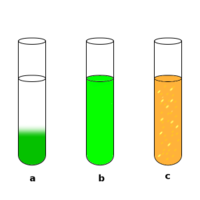
Photo from wikipedia
Robust and accurate analysis of cell-population heterogeneity is challenging but required in many areas of biology and medicine. In particular, it is pivotal to the development of reliable cancer biomarkers.… Click to show full abstract
Robust and accurate analysis of cell-population heterogeneity is challenging but required in many areas of biology and medicine. In particular, it is pivotal to the development of reliable cancer biomarkers. Here, we prove that cytometry of reaction rate constant (CRRC) can facilitate such analysis when the kinetic mechanism of a reaction associated with the heterogeneity is known. In CRRC, the cells are loaded with a reaction substrate, and its conversion into a product is followed by time-lapse fluorescence microscopy at the single-cell level. A reaction rate constant is determined for every cell, and a kinetic histogram "number of cells versus the rate constant" is used to determine quantitative parameters of reaction-based cell-population heterogeneity. Such parameters include, for example, the number and sizes of subpopulations. In this work, we applied CRRC to a reaction of substrate extrusion from cells by ATP-binding cassette (ABC) transporters. This reaction is viewed as a potential basis for predictive biomarkers of chemoresistance in cancer. CRRC proved to be robust (insensitive to variations in experimental settings) and accurate for finding quantitative parameters of cell-population heterogeneity. In contrast, a typical nonkinetic analysis, performed on the same data sets, proved to be both nonrobust and inaccurate. Our results suggest that CRRC can potentially facilitate the development of reliable cancer biomarkers on the basis of quantitative parameters of cell-population heterogeneity. A plausible implementation scenario of CRRC-based development, validation, and clinical use of a predictor of ovarian cancer chemoresistance to its frontline therapy is presented.
Journal Title: Analytical chemistry
Year Published: 2019
Link to full text (if available)
Share on Social Media: Sign Up to like & get
recommendations!